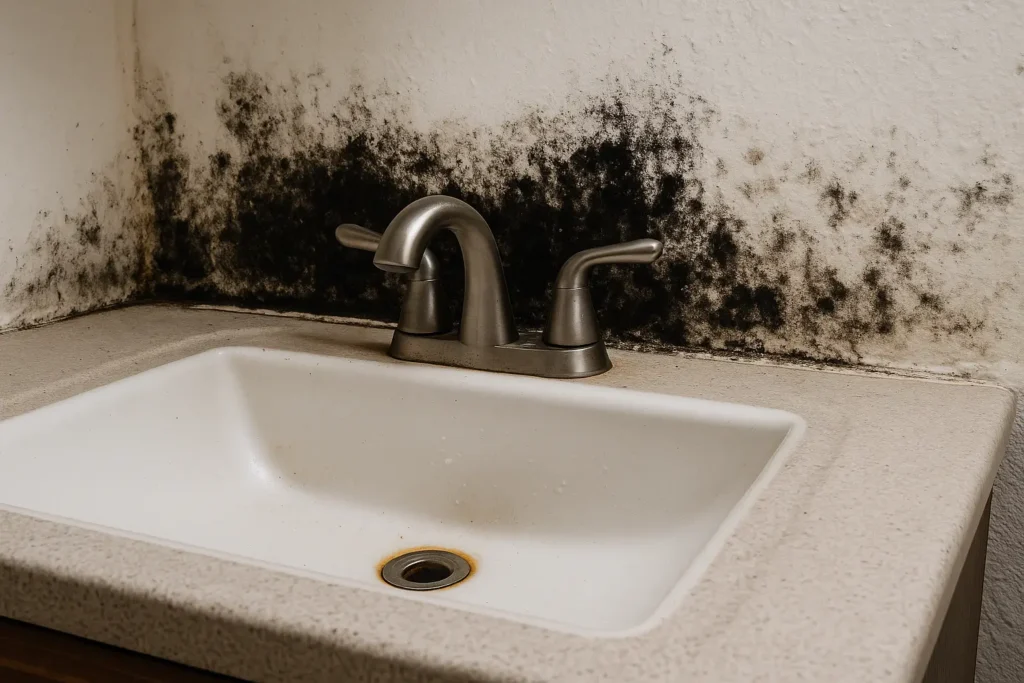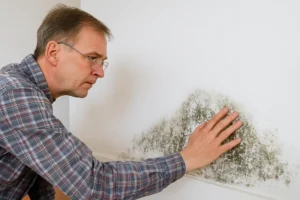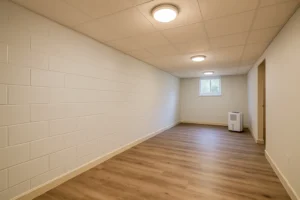You’re doing the dishes or brushing your teeth, and then you notice it. A strange black slime or fuzzy buildup creeping around the sink drain. Maybe it smells a little musty. Maybe it’s slimy to the touch. You clean it… But it keeps coming back.
That black stuff in your sink drain might be black mold. And yes, it can be dangerous, especially if it’s been growing unchecked for a while.
In this article, we’ll explain what black mold in sink drains is, why it forms, when it becomes a health concern, and what you can do about it.
What Is Black Mold in a Sink Drain?
Black mold in a drain is typically a form of fungus that grows in damp, dark, nutrient-rich places, like your kitchen or bathroom sink. While not all black-colored mold is toxic, one type, Stachybotrys chartarum (commonly called toxic black mold), produces harmful mycotoxins that can affect your health.
- Soap scum
- Food particles
- Hair and skin cells
- Moisture and heat
These conditions make sink drains a perfect spot for mold and bacteria to grow.
Is Black Mold Dangerous?
It can be. Not every black mold in a drain is immediately harmful, but constant exposure to mold over time can trigger health symptoms, especially for:
- People with asthma
- Allergy sufferers
- Elderly individuals
- Infants and children
- Anyone with a weakened immune system
The danger increases when:
- Mold spores become airborne
- Mold spreads into hidden parts of your plumbing or cabinets
- It’s left uncleaned for extended periods
Breathing in these spores or having contact with contaminated water can cause mild to severe health reactions.
Health Symptoms Linked to Mold in Drains
Even mold hiding inside a drain can release spores into the air or splash moldy water onto surfaces.
Common symptoms include:
- Coughing, sneezing, or wheezing
- Irritated eyes, nose, or throat
- Skin rashes or itchiness
- Headaches or dizziness
- Sinus pressure or nasal congestion
If you have asthma or mold allergies, exposure might trigger more intense flare-ups or breathing difficulties.
Why Does Mold Keep Coming Back in My Sink Drain?
Mold will return if the root cause isn’t fixed. Here’s why it’s so persistent:
- Warmth + moisture: Hot water from cooking or washing creates humid air.
- Poor drainage: Slow drains keep the area damp.
- Organic buildup: Food, oils, or toothpaste are all mold “food.”
- Hidden growth: Mold can grow down inside pipes or behind/under sink components.
Wiping around the drain only removes surface mold. If it’s deeper in the plumbing or surrounding structure, it’ll return quickly.

Can Black Mold in the Drain Spread?
Yes, and this is where things can go from gross to serious.
If left untreated:
- Mold spores can spread into cabinets or walls
- It may reach areas under the sink, including wooden cabinetry or drywall
- Moisture can attract other pests, like cockroaches or drain flies
- Musty smells can linger in your kitchen or bathroom
Once mold spreads behind walls or under surfaces, it becomes much harder and more expensive to remove. That’s when it’s time to bring in professionals.
How to Clean Mold from a Sink Drain
If the mold is minor and limited to the visible drain area, you can try the following cleaning steps:
What You’ll Need:
- Rubber gloves
- Scrub brush or old toothbrush
- White vinegar or baking soda
- Boiling water
- Hydrogen peroxide (optional)
Cleaning Steps:
- Boil water and pour it slowly down the drain to loosen grime and kill surface bacteria.
- Sprinkle baking soda into the drain, followed by vinegar. Let it fizz for 10–15 minutes.
- Scrub the drain and nearby surfaces.
- Rinse with more boiling water.
- For persistent mold, use hydrogen peroxide (3%) and let it sit before scrubbing again.
Important: Avoid bleach in your drains as it can create toxic fumes, especially in combination with other cleaners.
When to Call a Professional
It’s time to get expert help if:
- Mold keeps returning after multiple cleanings
- There’s a strong, musty smell under the sink
- Cabinets, walls, or flooring near the sink show signs of mold
- You experience unexplained health symptoms
- You suspect water damage or leaks under the sink
A professional restoration team can:
- Detect hidden mold behind and under sinks
- Dry and clean affected areas
- Remove and replace contaminated materials safely
- Prevent future mold from coming back
Why Tradewinds Restoration Is the Right Call
At Tradewinds Restoration, we’ve seen what starts as “just a little black stuff” around a sink turn into a much bigger mold problem. We know where to look, how to treat it, and most importantly, how to stop it from spreading.
When you call us, we:
- Use moisture detection tools to locate hidden mold
- Provide professional mold removal and sanitation
- Repair or replace any damaged drywall or wood
- Offer advice to help prevent future mold growth
Don’t let a small drain problem lead to long-term damage or health risks.
Call Tradewinds Restoration today if you think black mold may be hiding around your sink drain. We’re here to help clean it up and keep your home safe.
Don’t Ignore That Black Stuff
Mold in your sink drain might seem minor at first, but it’s a sign of a larger problem. Left alone, it can lead to health issues, home damage, and a persistent battle with odors and stains.
The good news? You can catch it early. And if it’s already out of control, Tradewinds Restoration is here to help.





